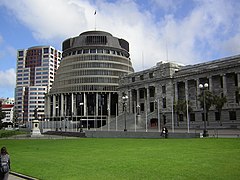Beehive (New Zealand)
| Executive Wing of Parliament | |
|---|---|

Bowen House (left), the Beehive (centre) and Parliament (right). A very similar view of the latter two buildings features on New Zealand's $20 banknote.
|
|
|
Location in Wellington
|
|
| Alternative names | Beehive, Whare Mīere |
| General information | |
| Address | Corner of Molesworth Street and Lambton Quay, Wellington |
| Coordinates | 41°16′42″S 174°46′36″E / 41.2784°S 174.7767°ECoordinates: 41°16′42″S 174°46′36″E / 41.2784°S 174.7767°E |
| Construction started | 1969 |
| Completed | 1981 |
| Inaugurated | May 1977 |
| Renovated |
|
| Owner | Government of New Zealand |
| Height | 72 metres (236 ft) |
| Technical details | |
| Floor count | 10 |
| Design and construction | |
| Architect | Sir Basil Spence |
| Structural engineer | Ministry of Works |
| Renovating team | |
| Architect | Warren and Mahoney |
| Website | |
| official website | |
| Designated | 24 July 2015 |
| Reference no. | 9629 |
The Beehive is the common name for the Executive Wing of the New Zealand Parliament Buildings, located at the corner of Molesworth Street and Lambton Quay, Wellington. It is so-called because of its shape is reminiscent of that of a traditional woven form of beehive known as a "skep". It is registered as a Category I heritage building by Heritage New Zealand.
Scottish architect Sir Basil Spence provided the original conceptual design of the Beehive in 1964. The detailed architectural design was undertaken by the New Zealand government architect Fergus Sheppard, and structural design of the building was undertaken by the Ministry of Works. The Beehive was built in stages between 1969 and 1979. W. M. Angus constructed the first stage - the podium, underground car park and basement for a national civil defence centre, and Gibson O'Connor constructed the ten floors of the remainder of the building.
Bellamy's restaurant moved into the building in the summer of 1975–76 and Queen Elizabeth II, Queen of New Zealand, unveiled a plaque in the reception hall in February 1977. The Prime Minister, Robert Muldoon, formally opened the building in May 1977. The government moved into the upper floors in 1979. The annex facing Museum Street was completed in 1981.
Renovations were carried out and the interior was modernised between 1998 and 2006 to plans by Christchurch architecture firm Warren and Mahoney. In 2013 and 2014, the roof was repaired and windows replaced.
In July 2015, Heritage New Zealand declared the Beehive "of outstanding heritage significance for its central role in the governance of New Zealand". Blyss Wagstaff of Heritage New Zealand called it "one of the most recognisable buildings in the country. Heritage New Zealand assigned the highest rating for a historic place, Category I, to the building. The original application for the heritage designation was made by Lockwood Smith, a former Speaker of the House of Representatives. The heritage registration with the list number 9629 became effective on 24 July 2015. The tunnel to Bowen House is specifically excluded from the heritage registration.
...
Wikipedia

